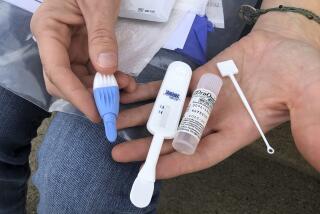An old way to fight AIDS
PRESIDENT BUSH HAS BEEN a reliable ally in the global fight against AIDS, proposing to increase federal funding to about $4 billion next year. With so much at stake, efficiency is vital, and according to a growing body of research, one procedure that is relatively inexpensive and can drastically reduce the transmission of AIDS is male circumcision.
Last fall, the first rigorous trial on the subject conducted in South Africa found that circumcised men are 60% less likely to contract HIV. Researchers, who halted the study early because the results were so convincing, suspect that the foreskin contains a concentration of cells that are easily infected by the virus. Similar studies in Uganda and Kenya are expected to release their preliminary findings this summer. If they’re similar, as many predict, health officials and donor countries such as the U.S. should help increase access to a safe and affordable procedure that has gone out of favor in most of the world.
Globally, only a quarter of men are circumcised, and rates are exceptionally low in many areas where HIV is dangerously prevalent, including India, Asia and southern Africa. Even with the increased availability of antiretroviral drugs, AIDS is getting worse in many parts of the world. In 2005, there were 5 million new cases worldwide (including 700,000 children), and 3 million people died of the disease.
Since the South African study was released late last year, health officials in countries such as Botswana and Swaziland have begun phasing in adult and infant circumcision programs, and waiting lists for the procedure at clinics are growing. If public clinics are overrun, people may turn to rural doctors, in which case dangerous and even deadly infections could occur. There also is concern that newly circumcised men may increase risky behavior, so any circumcision program should be accompanied by a strong message reinforcing the need for safe sex.
To a lesser degree, the issue has relevance in the United States. Overall circumcision rates have fallen to just half of all men in recent years, and 16 states -- including California -- have cut funding for the surgery because of an incorrect belief that it has no medical benefit. Although HIV rates are considerably lower in the United States than in other countries, they are highest among minorities and the poor. HIV rates in those populations could climb once their children become sexually active.
The United States is to be commended for increasing its funding for HIV prevention in recent years. And the Group of 8 industrialized nations has promised to provide universal access to AIDS treatments by 2010. Properly planned circumcision programs should be part of both efforts.
More to Read
Sign up for Essential California
The most important California stories and recommendations in your inbox every morning.
You may occasionally receive promotional content from the Los Angeles Times.










